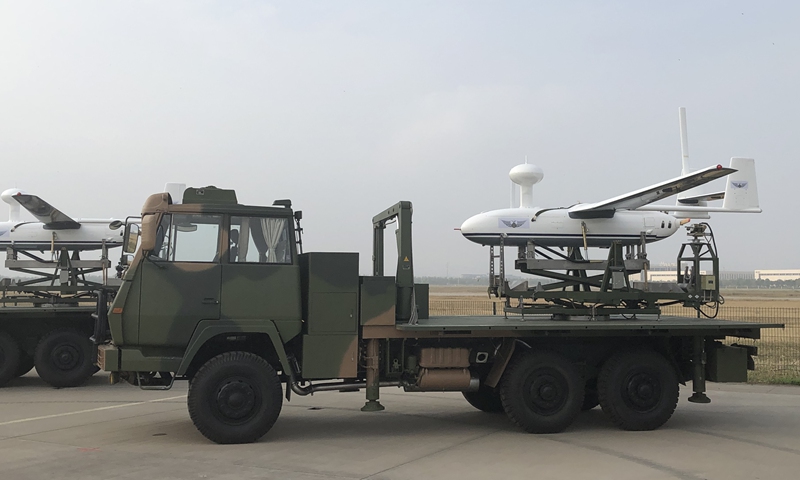Taiwan authorities likely failed to detect PLA helicopters as they announced first ever detection of a KVD-001 reconnaissance UAV
By Leng Shumei Published: Sep 12, 2022 09:21 PM
A KVD-001 UAV displayed at the 5th China Helicopter Exposition in Tinjian in 2019 Photo: Liu Xuanzun/GT
The Taiwan authorities had likely failed to detect helicopters of the People's Liberation Army (PLA) Army Aviation Force, observers said, as Taiwan armed forces authority announced on Sunday that they had for the first time detected a KVD-001 Unmanned Aerial Vehicle (UAV), which usually serves as communication relay for helicopters.
Taiwan authorities said they had detected eight PLA aircraft and five PLA naval ships operating in waters near Taiwan island on Sunday, according to Taiwan media.
Two military planes - Shenyang J-11 fighter jets - flew across the "median line" of the Taiwan Straits opposite northern Taiwan, while a KVD-001 drone crossed the "median line" further north, the Taiwan defense authority was quoted by local media as saying.
The PLA has been conducting normal military operations around Taiwan island since early August following the reckless and provocative visit of US house speaker Nancy Pelosi.
Taiwan authorities announced they detected, on September 5, a PLA BZK-007 UAVs . It is the first time for the Taiwan authorities to reveal the type of the PLA UAVs they detected.
On both September 8 and 9, the PLA UAVs were also detected operating near the island. The aircraft types also included BZK-005 and TB-001, according to media reports.
The KVD-001 is a tactical UAV of the PLA Army Aviation Force used mainly for reconnaissance and damage assessment. The UAV guides the PLA Army Aviation Force aircraft to attack when it finds a target, Song Zhongping, a Chinese military expert and TV commentator, told the Global Times on Monday.
In some harsh battlefield conditions, the UAV could also serve as a communication relay, according to Song.
At the 5th China Helicopter Exposition held in Tianjin in 2019, the Global Times learned that the KVD-001 is a multi-purpose UAV, an improved version of the JWP02 medium-range general-purpose UAV.
It is mainly composed of an aircraft sub-system, a data link sub-system, a ground control sub-system, a mission equipment sub-system and comprehensive support sub-system as well as other components, according to an introduction to the UAV at the exposition.
The UAV has the functions of long-distance communication relay, battlefield reconnaissance and surveillance and target irradiation guidance. It can extend the army's aviation command communication link, provide command communication relay between the army's aviation ground command post and air formations, and effectively improve the army's aviation long-distance command capability, according to the introduction.
The UAV can also enrich the means of army aviation reconnaissance, enhance reconnaissance ability and realize real-time reconnaissance and surveillance over the battlefield situation and key points. It can cooperate with helicopters to conduct attacks instead of manned aircraft, read the introduction.
Helicopters, especially military helicopters, have to fly very low to conduct effective penetration. Under this circumstance, it requires UAVs to conduct reconnaissance and send data of the targets to the helicopters in order to allow the latter to conduct effective attacks, Song explained.
According to a 2021China Central Television program which introduced the KVD-001 UAV and showed a cooperative drill between the UAV and helicopters, the UAV was sent to the battle field in advance and supervised, recognized and follows the target at an altitude of more than 1,000 meters.
The KVD-001 UAV sent real-time data of the target to the controlling center. The helicopters took off and precisely and quickly locked onto their targets and conducted attacks, according to the CCTV program.
Military observers suspect that as the KVD-001 UAV usually serves as a communication relay for helicopters, it is very likely that the UAV was also cooperating with helicopters on Sunday during a PLA exercise, but the Taiwan authorities had failed to detect the PLA helicopters that were flying at extreme low altitudes.
Song noted that detection of the KVD-001 drone near Taiwan island probably indicates that the PLA Army Aviation Force would serve as the main force if a war bursts out in the Taiwan Straits.






